February 17, 2023
Air Date: February 17, 2023
FULL SHOW
SEGMENTS

Big Oil Bid in Alaska
View the page for this story
A major plan by oil giant ConocoPhillips to drill in Alaska’s North Slope is poised to move ahead after preliminary approval by a federal agency, though it still needs President Biden’s final consent. The potentially lucrative Willow drilling project on federal land could dump millions of tons of climate disrupting carbon into the atmosphere over its lifetime and pose risks to the health of nearby Alaska Native communities and biological diversity. Andy Moderow is Alaska State Director for the Alaska Wilderness League and joins Host Steve Curwood to discuss. (11:16)

Beyond the Headlines
/ Peter DykstraView the page for this story
Journalist Peter Dykstra joins Host Steve Curwood this week to discuss the recent Ohio train derailment, which sent 50 cars carrying toxic chemicals including vinyl chloride careening off their tracks. They also discuss the proposed more efficient energy standards for washing machines, refrigerators, and freezers. For a history lesson, they dive into a prescient 1969 paper warning that the Arctic pack ice is thinning and the summertime ocean at the North Pole would soon become open water. (05:39)

Note on Emerging Science: Electric Honeybees
/ Fern AllingView the page for this story
A recent study from the University of Bristol reveals how large insect swarms may affect the electrical charge of the atmosphere. Living on Earth’s Fern Alling explains the phenomenon and the findings. (02:02)

High Levels of PFAS in Wild Freshwater Fish
View the page for this story
PFAS “forever” chemicals have widespread health impacts from cancers to reproductive disorders. A recent study revealed high levels of PFAS in wild-caught, American freshwater fish. David Andrews, a senior scientist with the Environmental Working Group, joined Living on Earth’s Bobby Bascomb to discuss the results and the impact on consumers. (09:58)
The Next Chapter of the Living on Earth Book Club
The cuddly Koala is one of the most charismatic and beloved species on Earth, but massive wildfires and habitat loss threaten their very existence. Tune in on March 2nd as we talk with award-winning Australian author Danielle Clode about her new book “Koala: A Natural History and an Uncertain Future", which takes us on a journey up into the trees to discover the remarkable physiology and ecology of koalas. ()

BirdNote®: Red-Crowned Cranes Dance on Hokkaido
/ Michael SteinView the page for this story
In Japan cranes are said to be a totem of luck and longevity. BirdNote®’s Michael Stein describes their remarkable dance ritual. (01:53)

Black Hair Care Products & Toxic Exposure
View the page for this story
Black women in America commonly use hair relaxers and leave-in conditioners to straighten and smooth their textured hair. But many of these products contain hormone-disrupting chemicals, which are associated with health problems such as early menarche, preterm birth, diabetes, and cancer. Dr. Tamarra James-Todd, an epidemiologist at the Harvard T.H. Chan School of Public Health, spoke with Host Steve Curwood. (15:10)
Show Credits and Funders
Show Transcript
230217 Transcript
HOSTS: Steve Curwood
GUESTS: David Andrews, Andy Moderow, Tamarra James-Todd
REPORTERS: Fern Alling, Peter Dykstra, Michael Stein
[THEME]
CURWOOD: From PRX – this is Living On Earth.
[THEME]
CURWOOD: I’m Steve Curwood.
Even tiny amounts of PFAS chemicals in drinking water are harmful to our health but that's nothing compared to what researchers are finding in freshwater fish.
ANDREWS: Those drinking water standards are in the low parts per trillion, and the levels in fish were thousands to tens of thousands of times higher. Consuming a single fish serving, and these are freshwater wild caught or locally caught fish, would be equivalent to drinking over a month of contaminated drinking water.
CURWOOD: The Willow oil drilling project in Alaska could bring huge climate consequences if approved.
MODEROW: The project would have 287 million metric tons of carbon emitted during the life cycle of the project. That's equivalent to 76 US coal plants burning for one year, about a third of the coal plants in our country.
CURWOOD: That and more this week on Living on Earth – Stick Around!
[NEWSBREAK MUSIC: Boards Of Canada “Zoetrope” from “In A Beautiful Place Out In The Country” (Warp Records 2000)]
[THEME]
Big Oil Bid in Alaska

An aerial photo of an exploration pad for ConocoPhillips’ Willow Project. (Photo: courtesy of ConocoPhillips)
CURWOOD: From PRX and the Jennifer and Ted Stanley Studios at the University of Massachusetts Boston this is Living on Earth. I’m Steve Curwood.
President Biden’s campaign pledge to stop extracting fossil fuels from federal lands is facing one of its biggest tests so far. A long-running effort by oil giant ConocoPhillips to drill for oil in a reserve neighboring the Arctic National Wildlife Refuge was recently given the green light by the federal Bureau of Land Management and awaits Joe Biden’s final approval. The Willow project, as it is known, was initially approved by the Trump Administration and would open the largest new oil field on US public land, with the potential of eventually tapping 3 billion barrels of oil. It would also dump millions tons of climate disrupting carbon into the atmosphere over its lifetime and pose risks to the health of nearby Alaska Native communities and biological diversity. Environmental impact concerns have delayed the project until now, but the recent BLM rulings mean Interior Secretary Deb Haaland and President Biden must decide as soon as March 1st if this Arctic drilling project can proceed. So far the Biden administration has already approved more than 6,000 permits for new oil and gas drilling on federal public lands, outpacing the first two years of the Trump administration. Some see a credibility gap between those new permits and Mr. Biden’s pledge to end new oil and gas leasing as part of his agenda to reduce US carbon emissions by 50 percent in the next 7 years. Andy Moderow is Alaska State Director for the Alaska Wilderness League and joins me now from Anchorage. Welcome to Living on Earth!
MODEROW: Thank you. Thanks for having me.
CURWOOD: So this is a big project, Andy; just how big? How much oil are we talking about here? How much in the way of greenhouse gas emissions are we talking about?
MODEROW: Yeah, the project would have 287 million metric tons of carbon emitted during the lifecycle of the project. That's equivalent to 76 US coal plants burning for one year, about a third of the coal plants in our, in our country. So it's a step backwards to unleash that in the region. On top of that, ConocoPhillips has told investors that it doesn't stop at Willow with just 600 million barrels of oil, but they've also identified 3 billion barrels in the region that could also be produced in decades to come, and that they've designed the project for expansion. So we're actually talking about more than just Willow -- a massive project in and of itself -- but also potential expansion in decades to come. And that's what has us really concerned.

ConocoPhillips’ existing oil fields in the Greater Kuparuk Area of Alaska’s North Slope. (Photo: courtesy of ConocoPhillips)
CURWOOD: Now, some make the argument that the Willow project is located in something known as the National Petroleum Reserve, next to the Arctic National Wildlife Refuge, with this land set aside as a petroleum reserve many presidencies ago, and hey, it's a petroleum reserve, it should be extracted. Your response?
MODEROW: Yeah, so the history of this landscape, it was actually a naval petroleum reserve, founded about 100 years ago, when securing a supply of oil for boats was important. Clearly, times have changed. The administrations that have come actually changed the management of the region, to include preserving the surface values, and making certain that preservation of land is also a critical consideration. We also see this White House realizing we can't keep extracting oil, and finding new oil to extract if we're going to solve this climate crisis. So while the area has a variety of management obligations, we believe that that's been fulfilled by the oil and gas development that's taken place to date in the region. And the oil should be reserved, it needs to be reserved for our climate, in the ground. So that's the position we're taking on that. And the name does not reflect the obligation of the agency in how they manage it today.
CURWOOD: Now, along with the huge climate implications of this, there are important local, human and ecological impacts as well. Talk to me about some of those.
MODEROW: Yeah, the region of the NPR-A that we're talking about is a very wet area, with lots of wetlands and streams and rivers that support a variety of life, ranging from caribou herds that are some of the last unimpeded land migrations we have in North America, through migratory bird routes, that see birds that travel all around the country, and come up to Alaska seasonally. So there's a lot of life in the region. There's also the community of Nuiqsut, which is basically getting surrounded right now by development projects. And if the project moves forward, they've expressed concern, both the city of Nuiqsut and the native village of Nuiqsut, that there are subsistence concerns for how they gather their traditional foods. There's health concerns, air quality concerns, road concerns. Just last year, the community of Nuiqsut had some very scary times when a oil and gas well blew out and released uncontrolled emissions into the air. And still today, we have questions about what happened there. The state is actually charged with looking into incidents like that. And they keep pushing off a public hearing to consider impacts and consider issues related to that release. So that is one of the issues at play here as well. Even though I will add that, you know, no population is a monolith, right. And Alaska Native communities do rely on the income from development. But the community closest to development has been pretty outspoken lately about their fears and concerns about this issue. So that's another thing that the Biden administration really needs to take seriously, as they weigh this decision in the final days.

The wetland landscape of the National Petroleum Reserve – Alaska, where the Willow oil drilling project is proposed to be developed (Photo: Bob Wick, BLM)
CURWOOD: How much is this worth to ConocoPhillips to develop? What kind of money are we talking about here?
MODEROW: I think Conoco expects to make a great deal of profits off this project. And what we've seen in recent years with high oil prices, in part due to the war in Ukraine, is that oil companies are making tens of billions of dollars. And so the cost of development of the project is about $8 billion. But if you, you know, look forward, I think they see a potential big asset on their balance sheet.
CURWOOD: And what about the revenues to the people of Alaska and the federal government under the leasing rules?
MODEROW: Yeah, it's a really good question, because the state of Alaska has been on this oil roller coaster, relying too heavily on an extractive industry that's non renewable by definition. Last year, the state of Alaska brought in a little over $3 billion from oil and gas taxes in the state. If you look at Conoco's expectation for the Willow project over 30 years, they estimate the project will bring in about $1.3 billion to the state. That's a little over $40 million a year during the life of the project, about 1% of what the state relies on. So this won't solve Alaska's fiscal crisis if it moves forward.
CURWOOD: What about the social cost of the carbon that's going to be released in this process?
MODEROW: Yeah, the government's own EIS estimates about $20 billion of potential impacts from the carbon if it is released from this project, and you weigh that against the $4 billion the federal government will get, it doesn't seem like a wise investment for the people of this country or for Alaskans. The only investors that this makes sense for is for Conoco's private investors. And that's not how good climate policy should be made.
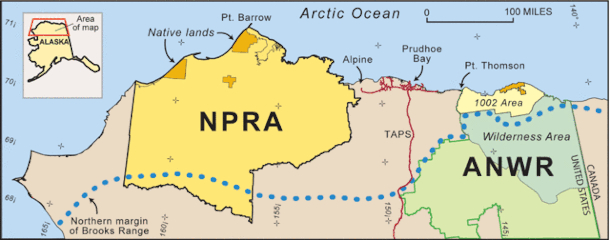
Map of northern Alaska showing location of the National Petroleum Reserve-Alaska, where the Willow Project would be developed, and the Arctic National Wildlife Refuge. (Photo:USGS)
CURWOOD: Now, the window for extracting and burning fossil fuels is rapidly shutting, given that scientists say we must halve greenhouse gas emissions by 2030. I mean, we're talking about just seven years from today. So how realistic are ConocoPhillips' prospects of actually extracting oil there? Or could this be more about say, shorter term interests of the company in being able to put the value of these reserves on their balance sheet?
MODEROW: Yeah, it's a really good question and to put yourself in the shoes of industry right now, you know, there's big questions about the viability of big expensive oil and gas plays. We've seen in the Arctic a bunch of banks, all major US banks, saying they are not interested in Arctic oil. We've seen insurers saying they don't want to insure the infrastructure because it's not worth the risk to their bottom line. I think Conoco is making a bet that when the oil starts being produced seven years from now, if Willow is allowed to move forward, that they'll have a market for that oil. But it could be something more tied to the short term interest on a balance sheet. I think we have to take the threat credibly; Conoco has told the Alaska delegation they want to start building it this winter, and they'll start running bulldozers as soon as they get approval. So I think the threat is real, you know, even if they don't end up developing the full reservoir. If they start building roads, the impacts in the local region will be felt. And so I really do think we have to take this threat seriously.
CURWOOD: Now, what about the argument that maybe half a loaf is okay, that the number of drilling sites that have been discussed could be reduced and therefore have less of an impact. Your read of that argument?
MODEROW: Yeah, thanks for that great question, because we've seen the Biden administration say they're considering a smaller project with three well sites and one deferred. Under President Trump, when the project was approved, it was also just three well sites and then deferrals of future sites. One of the main issues with the environmental analysis to date is that all the action alternatives would basically develop the full reservoir of oil, unleashing the full climate impact, should it be allowed to move forward. There's really not a half Willow on the table. And especially when you couple that with Conoco's stated expansion plans in the future, this is not going to be a small project, no way, shape or form. So it really is why no action is the correct option for our climate.

The Teshekpuk Caribou population in the northeast region of the National Petroleum Reserve in Alaska could be impacted by the Willow project. (Photo: Bob Wick, BLM)
CURWOOD: So to what extent are you saying, whether you have one straw in or three or four or five straws into the reservoir of oil there, the oil is going to come out eventually?
MODEROW: Yeah, I mean of the drill sites, if there was just one pad, if they chose the pad with the most oil below it, they have nearly half of the reservoir accessible from one pad alone.
CURWOOD: Now, I'm not an attorney, but looking at a statement that the Interior Department issued on the environmental impact here, it seems that they're not exactly favoring this. How correct is that interpretation?
MODEROW: I really appreciate the nuance you picked up when the Biden Administration released the Willow drilling plan. They stated that they have major concerns about the project in the press release, while also selecting a preferred alternative that would allow it to move forward. And they legally had to select a preferred alternative at that time. But what they signaled in that press release is I think we have an open window right now, the month after they released it or potentially longer to influence the final decision. It's clear the Biden administration is aware of and is considering the negatives and they have concerns about letting Willow move forward. So today and the weeks ahead really are the final call for the American public to get involved here.

Andy Moderow is Alaska State Director for the Alaska Wilderness League (Photo: courtesy of Andy Moderow)
CURWOOD: Andy Moderow is Alaska State Director for the Alaska Wilderness League. Thanks so much for taking the time with us today.
MODEROW: Thank you, appreciate it.
CURWOOD: We reached out to ConocoPhillips for comment. Dennis Nuss, Director of Media Relations and Crisis Communications for ConocoPhillips, provided a statement that read in part: "We believe this project fits with the Biden Administration’s priorities on environmental and social justice, facilitating the energy transition and enhancing our energy security." The full statement is posted on the Living on Earth website, loe dot org.
Statement from ConocoPhillips
Dennis Nuss, Director of Media Relations and Crisis Communications for ConocoPhillips:
"We believe this project fits with the Biden Administration’s priorities on environmental and social justice, facilitating the energy transition and enhancing our energy security – all while creating good union jobs and providing benefits to Alaska Native communities. Willow has undergone a comprehensive regulatory process for nearly five years with extensive public input, and Alaska Native communities on the North Slope have repeatedly voiced their support for the project. We look forward to a timely Record of Decision to enable this project to move forward in service of the public interest."
When asked about the possibility of expansion beyond the initial 600 million barrels outlined in the Willow Project, Mr. Nuss responded:
"Regarding your question about the 3 billion barrels, the SEIS analyzes the Willow Project, which involves approximately 600 million bbls of production and 180,000 BOPD at its peak. Any potential additional drilling pads would be subject to further NEPA review and analysis."
Related links:
- The Washington Post | “Biden team gives nod to huge Alaska oil project, setting up climate fight”
- Letter from the Native Village of Nuiqsut and City of Nuiqsut about Willow project impacts
- Anchorage Daily News |"Alaska Native leaders, US senators advocate for Willow oil project"
- Alaska Wilderness League on the Willow project
- Detailed information from ConocoPhillips on the Willow project
- Interior Department Statement on Proposed Willow Project
[MUSIC: Alice Coltrane, “Turiya & Ramakrishna” on Ptah The El Daoud, GRP Records Inc., UMG Recordings, Inc.]
CURWOOD: Coming up – how the federal government wants to help you save money and energy in your kitchen and laundry. Keep listening to Living on Earth.
ANNOUNCER: Support for Living on Earth comes from Sailors for the Sea and Oceana. Helping boaters race clean, sail green and protect the seas they love. More information @sailorsforthesea.org.
[CUTAWAY MUSIC: Alice Coltrane, “Turiya & Ramakrishna” on Ptah The El Daoud, GRP Records Inc., UMG Recordings, Inc.]
Beyond the Headlines
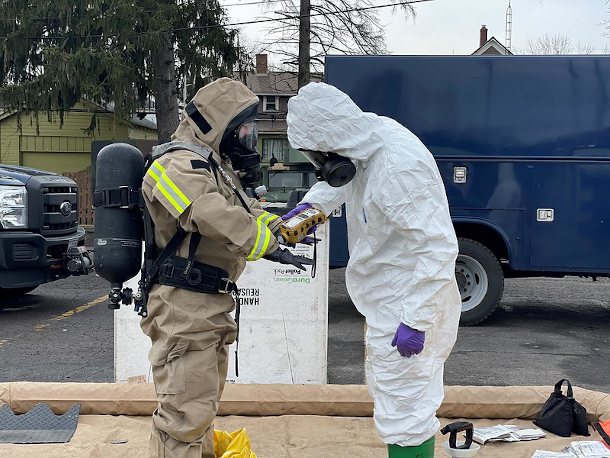
On February 7, 2023, members of the Ohio National Guard’s 52nd Civil Support Team prepared to assess hazards from the Feb. 3 derailment of a train carrying toxic chemicals near East Palestine, Ohio. (Photo: (U.S. Air National Guard photo by Capt. Jordyn Craft, Ohio National Guard Public Affairs)
CURWOOD: It’s Living on Earth, I’m Steve Curwood.
It's time now to take a look beyond the headlines with living on Earth commentator, Peter Dykstra. You there Peter, you got something for us today.
DYKSTRA: Major story that got in my opinion minor treatment in the national news, I'm talking about the train derailment in Ohio on the Ohio Pennsylvania border. Tanker car after tanker car contained toxic chemicals, including vinyl chloride, a known carcinogen. Local residents were evacuated, there were no immediate injuries among the train crew or local residents, but possible health impacts are something that are still a mystery. Some local residents have taken it to court, including asking for the responsible parties to pay for testing of all local residents in this incident that forced people to leave town that started a huge fire that got very little notice.
CURWOOD: Yeah, I mean, it was a really big deal. The governor of Ohio Mike DeWine asked the police to arrest people who refuse to evacuate they were so concerned how dangerous these chemicals are. And more and more of the petrochemical industry is interested in shipping chemicals around to make more and more plastic.
DYKSTRA: Right, they view plastic, the petrochemical industry as their safety valve no pun intended for the days when oil and natural gas are in decline over climate change concerns if they begin to disappear as a vehicle fuel, all of those petrochemical products can help keep the oil and gas industry alive. And in the case of this train another concern is that the right to know laws that used to be so common on the state and local and federal level have been eroded. That's happened ever since 911, when it was viewed, that giving the public and local fire departments and local safety people all the information about what toxic chemicals were involved in factories or trains or ships would be an open door for terrorists to take that information and make some pretty bad things with it. So right to know, is something that isn't widespread anymore. So it took a long time for those people in East Palestine, Ohio and towns across the state line in Pennsylvania to know what they were exposed to.
In February 2023 the Biden administration proposed stricter energy standards for household washing machines, refrigerators, and freezers to reduce emissions while also saving consumers money. (Photo: PlanetCare, Unsplash)
CURWOOD: Hey, what else do you have for us Peter?
DYKSTRA: There's been a proposal by the Department of Energy to make washing machines and refrigerators much cheaper to power and much more efficient by the year 2027. Right now, it's estimated that the greenhouse gas emissions in the US from washers and refrigerators are equal to the entire greenhouse output of the nation of Argentina. This would help a lot toward meeting climate change goals in just a few years.
CURWOOD: Talk to me about the numbers here, Peter. I'm sure the appliance manufacturers are saying wait, wait, wait, this is going to cost us a lot of money.
DYKSTRA: It may cost a lot of money at first. It's estimated it could cost $2 billion for appliance makers to retrofit that's opposed to consumer savings of over $3 billion. Not one time, but every year. And those reduced energy bills also mean reduced climate risk.
CURWOOD: And Peter at one point we unplugged an old freezer that we had and the thing was costing us maybe a buck or two a day to run, it was crazy.
DYKSTRA: We had the same thing in our house. There was an old refrigerator that we used as a backup when the kids grew up and moved out. We didn't need two refrigerators. We got rid of the old one, and our electric bills suddenly declined by about 25%.
CURWOOD: Hey, let's take a look back in history now, Peter.
DYKSTRA: Last week you and I talked about how Lyndon Baines Johnson back in 1965 was the first American President to mention the potential risks of co2 and climate change. But just four years later, on February 20 1969, there's a Norwegian born Arctic explorer named Bert Balkan, who warned that the Arctic ice pack is thinning. And he said the North Pole could be open ocean, quote within a decade or two unquote.
In February 1969, polar explorer and flier Bernt Balchen predicted that the Arctic pack ice is thinning and that the summertime ocean at the North Pole would become open water within a decade or two, something that actually happened by about the year 2000. (Photo: Kevin Lockwood, Flickr CC BY-NC 2.0)
CURWOOD: Well, he was right and he was wrong. That took about 30 years before people like Jim McCarthy were in boats at the North Pole and open water. But he was right about the trend. Certainly, huh.
DYKSTRA: He was right about it at the time. Someone else that was paying very close attention to the thickness of ice in the Arctic were the naval fleets of the United States of America and the Soviet Union. They kept very diligent measures of how thick the ice As was in case they ever needed to break through that ice with their submarines to fight a nuclear war, those numbers weren't revealed until after the fall of the Soviet Union. But they revealed something very alarming from all those tree huggers in the US Navy and the Russian Navy.
CURWOOD: And just these last 40 years, apparently, we've lost three quarters of the volume of the Arctic sea ice. We are changing things on this planet rapidly. Well, thanks, Peter. Peter Dykstra is a commentator with Living on Earth. We'll talk to you again real soon.
DYKSTRA: All right, Steve, thanks a lot. Talk to you soon.
CURWOOD: And there's more on the stories on the Living on Earth webpage. That's LOE dot ORG.
Related links:
- Grist | “The Ohio train derailment underscores the dangers of the plastics boom”
- Washington Post | “Washing machines and fridges could be much cheaper to power by 2027.”
- New York Times archives | “Expert Says Arctic Ocean Will Soon Be an Open Sea; Catastrophic Shifts in Climate Feared if Change Occurs Other Specialists See No Thinning of Polar Ice Cap”
[MUSIC: Wes Montgomery, “A Day In The Life” on A Day In The Life, UMG Recordings]
CURWOOD: Coming up alarming levels of PFAS chemicals in freshwater fish are being found but first this note on Emerging Science from Fern Alling.
[SCIENCE NOTE THEME]
Note on Emerging Science: Electric Honeybees
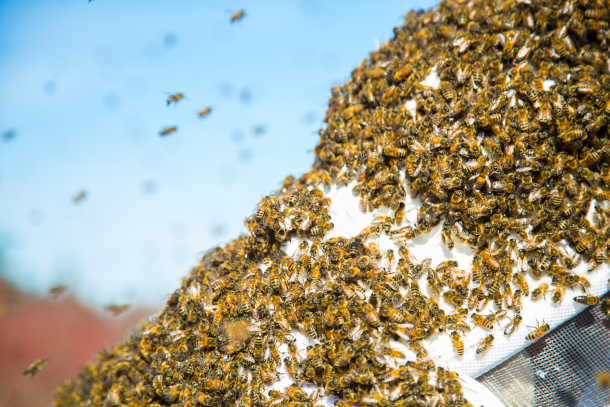
A honeybee hive (Photo: Edgar Chaparro on Unsplash)
ALLING: The Earth’s atmosphere holds an electric charge that is present even on clear, sunny days. This charge can be affected by things like lightning, precipitation, and radioactivity. Now, a study published in the journal iScience is pointing to another possible source of electric disturbance: insect swarms. The study was conducted by researchers at the University of Bristol School of Veterinary Sciences. They set up two electric monitors at a field station where several honeybee hives are kept. One monitor was placed near the hives, while the other was placed in an open field 150 feet away. Insects generate small amounts of static electricity when they fly, and it’s caused by the friction between their wings and surrounding air molecules. When swarms of bees passed over the monitor near the hives it detected changes in atmospheric charge, but the control equipment in the field did not. Using the data generated by their experiment, measurements of individual insects, and scientific records, the researchers developed a model to predict how swarms of different insects might affect atmospheric charge.
They found that the larger the insects and the more tightly they were packed, the higher the swarm’s charge density would be. One swarm of honeybees they measured had a charge density of 1,000 volts per meter, about eight times greater than a storm cloud’s.
But honeybee swarms are far smaller than clouds, so it’s unlikely bees have a similar impact on the weather. Locusts, on the other hand, can create massive swarms that span hundreds of miles, creating an even larger localized charge than bees. Scientists are still working to understand the overall impact insect swarms have on the atmosphere. But these initial findings were a shocking start. That’s this week’s note on Emerging Science, I’m Fern Alling.
Related links:
- Read the full study here
- Click here to learn how bees use electricity to find flowers
[SCIENCE NOTE THEME]
High Levels of PFAS in Wild Freshwater Fish
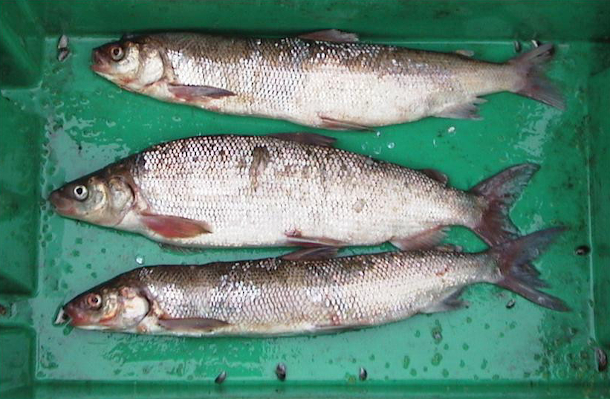
Whitefish from Lake Michigan, one of the Great Lakes whose fish population was found to be highly contaminated by PFAS. (Photo: NOAA Great Lakes Environmental Research Laboratory)
CURWOOD: Per and polyfluorinated substances commonly called PFAS are chemicals commonly used in everything from fast food wrappers and cookware to firefighting foam and carpeting. Decades of research indicates that PFAS are harmful to human health, with risks ranging from cancers to reproductive disorders to immune function disruption. And a recent study published in Environmental News, showed that wild-caught, American freshwater fish are often loaded with PFAS. Living on Earth’s Bobby Bascomb spoke with David Andrews, a senior scientist with the Environmental Working Group.
ANDREWS: So this is a study where we were looking for how are people being exposed to these chemicals. We know there's health concerns at very low concentrations. There have been a number of scientific studies that have shown that people who eat more fish have slightly higher levels of PFAS in their serum. But we wanted to kind of dive in and see what's the picture look like across the United States. Actually, we were very surprised to find that there were publicly available data sets. This is testing that had been conducted by the US Environmental Protection Agency, the most recent data was 2013 to 2015. But they actually took a random sample of streams and rivers across the country trying to get a representative sample of PFAS levels in freshwater fish across the country. And then there is also another set of data that — collected by the agency — where they sampled across the whole U.S. shoreline of the Great Lakes. So they're these two great data sets, they're actually 500 different sample locations. And these are fish that are important to anglers. And so this huge data set was something that we looked at in terms of how much PFAS are in these fish. And the results were really quite striking. compared to any other source of PFAS exposure. The levels in these fish are incredibly high and in the 10s of 1000S of parts per trillion.
.jpg)
A warning advising people who fish at Ford Lake, Michigan to not eat their catches due to the high levels of PFAS contamination. (Photo: Notorious4life, Wikimedia Commons)
BASCOMB: How does that compare to other forms of exposure, You know, from household products or water. People are very concerned about PFAS and water. How does the PFAS found in fish compared to other ways that people might be exposed?
ANDREWS: As far as I know this is likely the highest source of exposure for anyone who consumes these fish. And that's where it really stands out. What's been in the news, I guess recently in particular is PFAS contamination of drinking water for good reason. It's easy to test for there are methods to remove it from drinking water. And in a number of states as well as the federal government have set or are in the process of setting drinking water standards. But those drinking water standards are in the low parts per trillion in the levels in fish were 1000s to 10s of 1000s of times higher. And that's what really is quite striking. And we actually made a comparison showing that consuming a single fish serving, and these are freshwater wild caught or locally caught fish, would be equivalent to drinking over a month of contaminated drinking water.
BASCOMB: Wow, that's really concerning then. And I understand that you actually compared freshwater fish to grocery store fish, which is mostly farmed and ocean species. What were your findings there?
ANDREWS: So the Food and Drug Administration has done some testing of the food supply, which is actually really important, we believe they should be doing more testing still. But the testing they've done to date over the past three or four years has actually shown very low levels of PFAS contamination compared to these freshwater fish samples. We compared fish samples collected by the Food and Drug Administration. So these are grocery stores samples of fish that included both saltwater and marine fish, such as salmon, tuna, as well as farmed fish such as tilapia and catfish. And across the board, those levels were relatively similar, and on average, about 300 times lower than the concentration of PFAS and freshwater fish. So an incredible difference in potential exposure. We still think people should be consuming fish. Fish is the healthy source of protein. But when possible, these grocery store fish had much, much lower levels of contamination. And we actually think that you should switch to those.
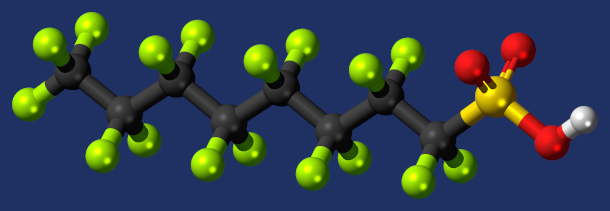
A ball and stick model of the chemical structure of PFOS, the polyfluoroalkyl cousin of PFAS chemicals. (Photo: Jynto, Wikimedia Commons)
BASCOMB: Well, many low income communities and people in the developing world depend on fish as a good source of protein. And we're always told that you know, fish is very healthy for us. Can you tell us more about that, please? And how concerning this is for communities that really depend on fish for their food.
ANDREWS: There was actually a study done by the New York State Department of Health that looked at a Burmese and Karen immigrant population who are consuming a lot of locally caught fish. And that study showed that in this population that was catching their own fish and eating it, their blood serum levels of PFAS were significantly above what's seen in the general population. So this is very concerning for communities that rely on fish for subsistence. And then this is something that we actually highlighted in the study as being a particular concern in a place where we think there needs to be national action because there are people who go out and catch fish for food and in particular freshwater fish. And there's also other groups that rely on fish for social and cultural reasons. And the concern is that these communities, often times they are marginalized communities, are those who don't have the income to replace locally caught fish with fish from the grocery store. They may have the highest exposures in the most impact from this contamination. And ultimately, I think it points to the need to really hold polluters accountable for this and come up with have a way to either drive cleanup of this which there are no easy solutions for or or somehow supply alternative sources of protein that are not contaminated to these groups.
BASCOMB: Well, we know very well that PFAS chemicals are a problem, we now understand that they're in freshwater and endangering fish and wildlife and ourselves. What can be done about it? Can it be removed in some way? Sounds expensive. But I mean, what are the next steps now that we know this is such an issue?
ANDREWS: There’s no easy way to remove these chemicals from waterways or from contaminated fish. And that's what's really frustrating in some ways. But it also points the need for immediate action to not make this worse, not continue the contamination. So we're calling for industry and the federal government to turn off the tap on ongoing contamination and end industrial releases of these chemicals into the environment and make sure that it's more strictly regulated. We also think that non essential uses of PFAS should be eliminated. So these chemicals have found their way into 100s and 1000s of different products. This is everything from fast food wrappers, to clothing, to products all around the house. And many of those uses are just completely unnecessary. I was actually a co-author on another paper that came out this week, establishing a framework for how we can eliminate non-essential uses of chemicals, and replace the current regulatory system. I mean, that would be a big change. But I think that the extent of this contamination in the scope of the problem really highlights the need for an entire change in how chemicals are regulated and how we deal with concerning chemicals, chemicals that that can cause such harmful impact on our bodies.
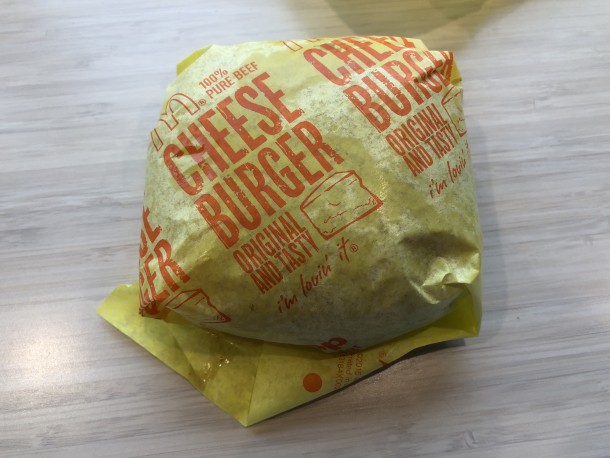
McDonald’s, one of the fast-food companies found to use PFAS in their packaging, vowed to stop using PFAS chemicals entirely by 2025. (Photo: Famartin, Wikimedia Commons)
BASCOMB: So the first thing we need to do is turn off the tap.
ANDREWS: Correct, that's the first thing we need to do is and ongoing releases into the environment. And we actually know this does help few PFAS chemicals. In particular PFOS used to make scotchguard and PFOA, a primary ingredient in producing Teflon, were phased out of the market starting in 2005, and over a 10 or 15 year period that their use in products in the United States has decreased significantly. And we're seeing levels of those contaminants go down in the environment as well as in fish. So that is a positive sign that shows that when these chemicals are no longer produced and put into products, that the concentration does go down over time, even though these are forever chemicals, the concentrations that we see in measuring the environment decrease. But there are a whole host, as we mentioned over 1000 of these chemicals that have been approved for use. And so the scope is much bigger than just a few chemicals that have been restricted to date.
BASCOMB: So do particular species of fish accumulate more PFAS chemicals than others? I mean, do we know that and you know, what kind of advice can you give to listeners who are you know, maybe waiting for summer to roll around so they can get back on the water and go fishing? How can they be safe when they go to you know, maybe put that fish in the frying pan at the end of the day.
ANDREWS: So we didn't see any differences between different species. And I will say we didn't we didn't pursue that avenue of analysis very far. But in other studies had been have been done. There's no real clear pattern of which fish have higher levels of PFAS contamination. So that is really quite interesting. And in some ways also a little bit frustrating too as a fisherman there's you don't know what what to try to catch that maybe safer. And ultimately, I think that points towards our one of our recommendations is that there should be consistent fish consumption advice across the country. There are currently 14 states that have specific fish consumption advice for PFAS, but it's not consistent, then we think that Americans, anglers across the country should get consistent advice from the government in terms of what is the safe exposure level. But ultimately from this analysis, we think that people who are going out fishing for freshwater fish that they consider catch and release and if possible, replacing that fish with a grocery store caught fish. I think that needs to occur until levels have come down. There's greater testing showing that contamination would not be a health concern, not the answer I want to give, but it's the answer that really comes out of this analysis.
CURWOOD: David Andrews, a senior scientist with the Environmental Working Group speaking with Living on Earth’s Bobby Bascomb.
Related links:
- Read the study here
- Learn more about how the EPA plans to address PFAS in the water system
- Learn about the Environmental Working Group’s work regarding PFAS
[MUSIC: Oscar Peterson Trio, “I Got It Bad And That Ain’t Good” on Night Train (Expanded Edition), The Verve Music Group.]
The Next Chapter of the Living on Earth Book Club
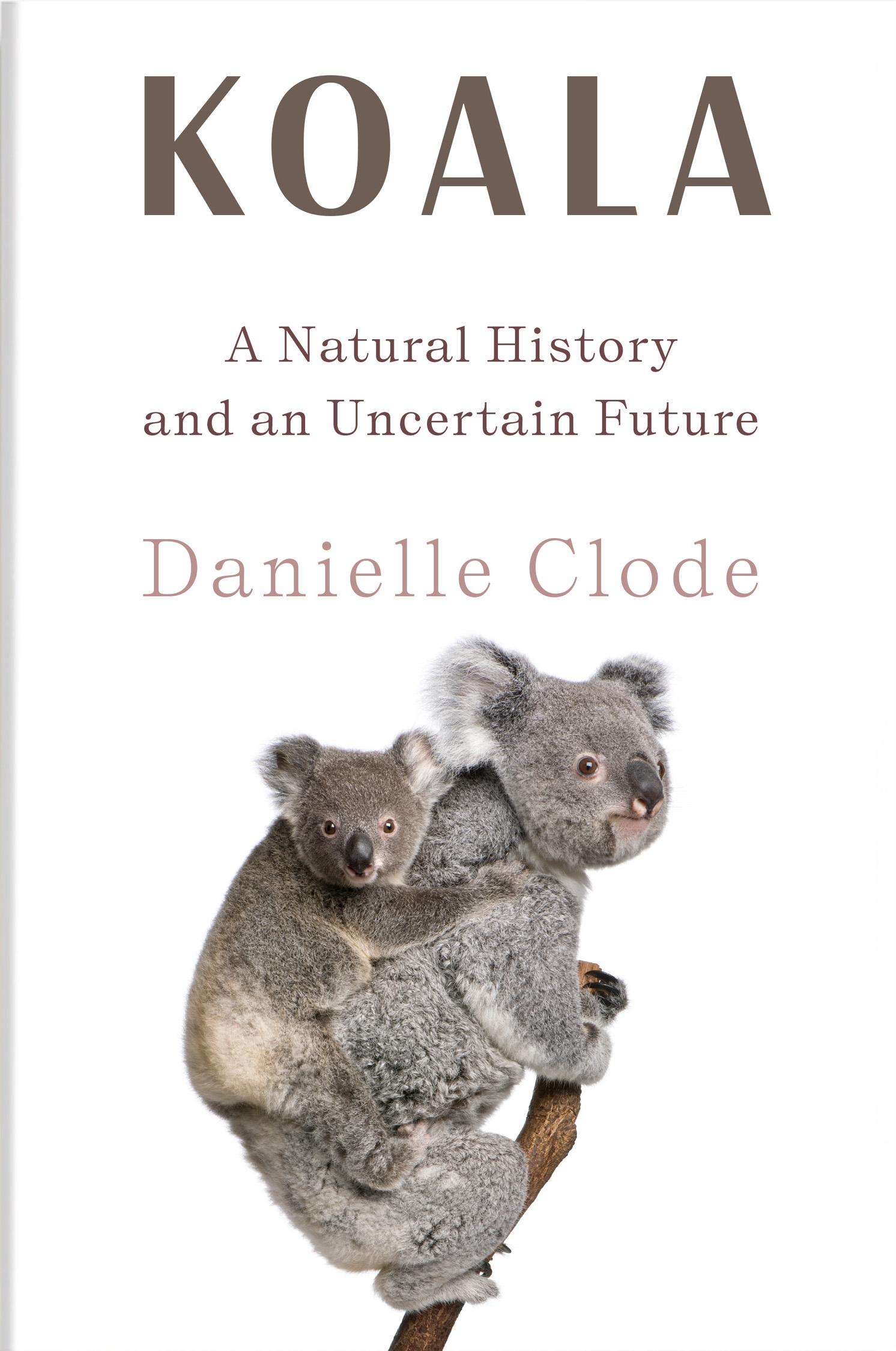
CURWOOD: Massive wildfires and habitat loss threaten their very existence of the cuddly Koala. In her new book “Koala: A Natural History and an Uncertain Future", award-winning Australian author Danielle Clode takes us on a journey up into the trees to discover the remarkable physiology and ecology of koalas. She joins us for the next Living on Earth Book Club livestream on March 2nd, and you’re invited! For details and to register for this free event go to loe.org/events.
Related links:
- CLICK HERE to register for this upcoming live event
- Purchase a copy of Koala: A Natural History and an Uncertain Future (Affiliate link helps donate to LOE and local indie bookstores)
[MUSIC: Oscar Peterson Trio, “I Got It Bad And That Ain’t Good” on Night Train (Expanded Edition), The Verve Music Group.]
CURWOOD: Coming up – In honor of Black History Month, we consider the chemical evolution of black hair care products. That’s just ahead on Living on Earth.
ANNOUNCER: Support for Living on Earth comes from Friends of Smeagull the Seagull and Smeagull’s Guide to Wildlife. It’s all about the wildlife right next door to you! That’s Smeagull, S - M - E - A - G - U - L - L, SmeagullGuide.org.
[CUTAWAY MUSIC: No em pingo D’agua, “Salvador” on Visom: Contemporary Instrumental Music From Brazel, by Egberto Gizmonti/arr.Mario Seve and Rodrigo Lessa, Visom Records/A Windham Hill Samplet]
BirdNote®: Red-Crowned Cranes Dance on Hokkaido
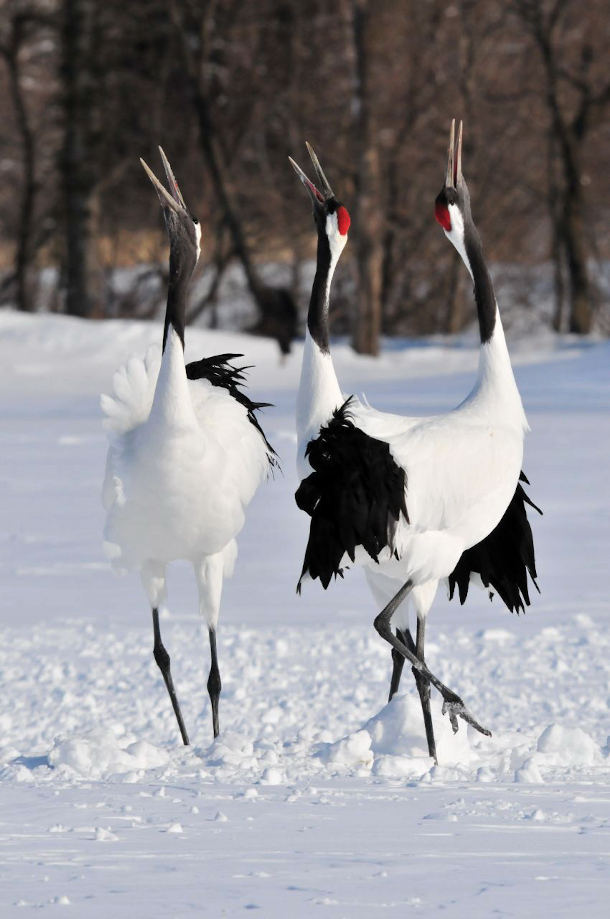
Red-crowned cranes dancing in Hokkaido, Japan (Photo: cyberfox, Wikimedia Commons CC BY 2.1 JP)
CURWOOD: It’s Living on Earth, I’m Steve Curwood.
[BIRDNOTE THEME]
CURWOOD: In Japan cranes are said to be a totem of luck and longevity. BirdNote’s Michael Stein has more.
BirdNote®
Red-crowned Cranes Dance on Hokkaido
[Red-crowned Crane pair unison calls]
On a snow-covered field in northern Japan, two majestic Red-crowned Cranes face one another, raise their heads toward the sky, and call in unison.
[Red-crowned Crane pair unison calls]
The slender cranes stand more than five feet tall. Their white bodies glisten like the snow. Their long, slim necks are mostly black. Their heads are topped by crimson crowns. Their bills are yellow spears.
As they call [Red-crowned Crane pair unison calls], the pair begins to dance. They bow to one another, then throw their heads over their backs, then bow again. The pair leaps into the air, at the same time raising their wings, flashing a bold banner of black. They prance, stiff-legged, then leap with wings aloft, again and again, like two immense butterflies fluttering above the snow.
[Red-crowned Crane pair unison calls]
The Red-crowned Cranes’ unison dance is a ritual the pair will perform together many times over the years, to strengthen their lifelong bond.
In Japanese tradition, the beloved crane is said to live 1,000 years and symbolizes longevity. The bird is celebrated in a remarkable feat of origami craft in which 1,000 paper cranes are cut and folded. As the tradition says: “Fold a thousand cranes and the gods will fulfill your heart’s desire.”
[Red-crowned Crane pair unison calls]
###
Written by Bob Sundstrom
Calls of Red-crowned Cranes recorded by David Farrow XC49791 www.xeno-canto.org/49791.
Images by Dan Hutcheson flickr.com/wildphotons, Andreas Nilsen flickr.com/solvsuper, and Francesco Veronesi flickr.com/francesco_veronesi
Producer: John Kessler
Executive Producer: Chris Peterson
© 2015 Tune In to Nature.org February 2015/2021 Narrator: Michael Stein
[Quotation from Peter Matthiessen The Birds of Heaven, 2001, p. 165.]
Video clip with cranes calling: http://ibc.lynxeds.com/video/red-crowned-crane-grus-japonensis/pair-calling-displaying
Video clip with cranes dancing: http://birdnote.org/video/2013/01/japanese-red-crowned-crown-courtship-dance
https://www.birdnote.org/listen/shows/red-crowned-cranes-dance-hokkaido
CURWOOD: For photos strut on over to the Living on Earth website, loe dot org.
Related link:
Learn more about this Birdnote episode here
[MUSIC: Minoru Muraoka, “Nogamigawa Funauta” on Bamboo, Mr Bongo / United Artists Records.]
Black Hair Care Products & Toxic Exposure
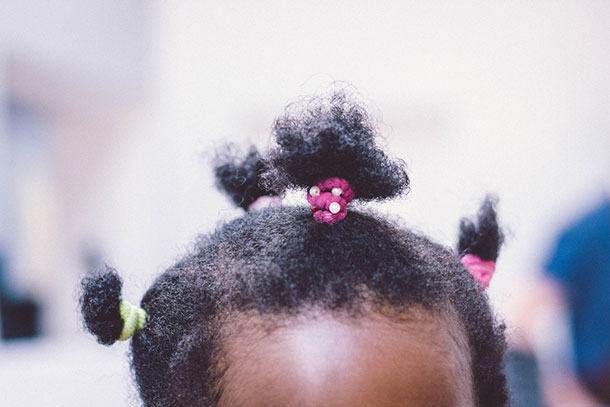
Dr. James-Todd says that as black people resist pressures to conform to white standards of beauty, more have come to embrace their natural hair. (Photo: Nina Strehl, Unsplash)
CURWOOD: In honor of black history month, we want to look back at one of the first African American women to become a self-made millionaire in the United States. Sarah Breedlove, better known by her married name Madam C.J. Walker, had 5 siblings and was the first one born in freedom in 1867, four years after the Emancipation Proclamation freed the rest of her family from slavery in the Confederate state of Louisiana. Madam walker went on to build a company that made hair care products especially for black women. She employed thousands of women to sell her products which were largely made of petroleum jelly, sulfur, beeswax, and violet extract for fragrance. Today black hair care products are a 2.5-billion-dollar global industry that includes, straighteners, relaxants, conditioners, gels, and foams. And according to a study by the Silent Spring Institute all of eighteen products they tested contained toxic chemicals that mimic estrogen in the body or disrupt the hormone system for women. So for a bit of our own history we dip into our archives. Here’s our 2018 interview with epidemiologist Tamarra James-Todd from the Harvard T.H. Chan School of Public Health. We started our chat considering the tremendous diversity in the black community from skin color to types of hair.
JAMES-TODD: So, there are different textures and different grades of hair from relatively straight hair to very curly, sometimes called “kinky” hair, and they have different requirements. It's really dependent on the shape of the hair shaft, but that can cause people to need to use different types of products.
CURWOOD: And people often don't like the hair they have. If it's straight, they want it curly. If it's curly, they want it straight, huh?
JAMES-TODD: I think that would be universal for most women. [LAUGHS] Definitely. But certainly in the black community I think that there are some real issues around hair and part of that is kind of social and cultural issues regarding what is seen as beautiful, with straight long hair being kind of the stamp of beauty -- oftentimes in American culture particularly, in Western culture -- and so, people will do different things to try to adhere to that standard of beauty.
CURWOOD: So, what kinds of hair products do black women typically use?
JAMES-TODD: So, oftentimes when I'm asked this question and when I first started this line of work, the first thing that would come up is, oh, hair relaxers. And so, thinking about things that people use, you know, whether it's every few months or a couple of times a year to straighten their hair. But what I think is often forgotten is things that we use daily such as hair oils, moisturizers, lotions, leave-in conditioners, gels -- kind of, you name it, that's what people are using to get the different styles that they want.
CURWOOD: Or heat... I mean, as an African-American growing up, I saw women with these really hot combs and I have to laugh out loud at Alex Haley's Autobiography of Malcolm X where he has this scene that Malcolm X tries to straighten his hair and his head is on fire so he sticks his head in a toilet to cool it down.
JAMES-TODD: Yes, that scene, I think, many, many women and some men can identify with... pressing, those pressing combs. So, it's not just chemicals, but it's also physical changes that people will try to do or undertake.
CURWOOD: So, what got you first interested in studying the potential health effects of chemicals in black women's hair?
JAMES-TODD: So, when I was a master’s student at Boston University, there was an interesting study of magazine advertisements advertised to white women versus black women. And there was a Ladies Home Journal article where it had an ad for white women being marketed to, kind of, anti-aging cream containing hormones. And the other magazine, which was kind of featured in this particular study, was from Essence magazine, a magazine commonly marketed and read by black women, and it was advertising placenta. And it was something that I remember seeing when I'd walk into, you know, a black hair supply or hair care store, and seeing placenta and just wondering, what exactly is that for? Why are people using that? And around that same time, an issue of Time magazine had come out, kind of querying why were girls starting their periods earlier and earlier. And somehow that just kind of clicked for me. Is it possible that what is in some of these hair products around hormones and so on… is that part of the reason why we're seeing earlier periods, particularly in black girls, which at the time there was a very large study that had reported that 60 percent of black girls had reached their periods by age 12 compared to only 30 percent or so of white girls. So, as a master’s student, that piqued my interest.
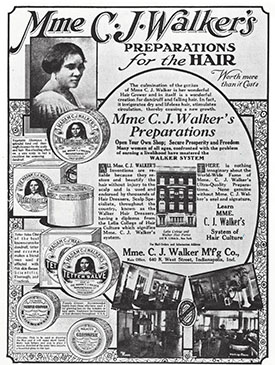
A 1917 Advertisement. Madam C. J. Walker, an entrepreneur and activist born in 1867, led the movement to create healthy hair care products designed specifically for black women. (Photo: Courtesy of Madam Walker Family Archives/A'Lelia Bundles)
CURWOOD: And the answer is?
JAMES-TODD: So, we did, in fact, do a study; as a doctoral student at Columbia University, I did a study called the Greater New York Hair Products Study where we did, in fact, go and we queried what types of hair products people are using. And we found that young girls who were using hair oils for a longer period of time and more frequently had a significantly higher risk of starting their periods earlier than girls who had never used hair oils. And you know, each year earlier that a girl starts her period, it’s an increased risk for developing breast cancer.
CURWOOD: So, I'm thinking that this is linked somehow to chemicals -- fancy name is endocrine disrupters -- hormone disrupters, chemicals that kind of mimic estrogen and other hormones. To what extent is this phenomenon linked to such chemicals, do you think?
JAMES-TODD: So, at the time we started looking at this because of another study that had come out of the small case series of four young African-American girls. They ranged in age from four months old to four years old, and they had all developed breast and pubic hair. So, incredibly young children…
CURWOOD: ...at four months?
JAMES-TODD: At four months old!
CURWOOD: … at four months!
JAMES-TODD: ...and interestingly enough, the pediatric endocrinologist that had seen these young girls asked the moms all sorts of questions about what products they were using, what they had been exposed to in the home. And the common thread he was finding was that all of the moms were using -- these were girls so they were all using hair oils and different types of care products on children. Quite frankly, this is something that happens probably daily in the black community. But when he sent those products out for independent laboratory testing, he found three different forms of estrogen. And so when we started looking at this, and thinking about, you know, are these endocrine disrupting chemicals? -- I wasn't even there yet -- I was just thinking, maybe we'll find estrogen in these products. He, in fact, did and when he told the moms to stop using these products, the breasts regressed and the pubic hair fell out. So, fascinating case series. And when we sent these products out roughly 10 years later, we did not find those three different forms of estrogen. But we did find parabens, phthalates, and other chemicals that are known to be endocrine disruptors. And so what we know now is that about 50 percent of products advertised to black women contain these types of chemicals compared to maybe only seven percent that are advertised white women.
CURWOOD: You mentioned earlier periods. What are some of the health problems that have been linked to endocrine-disrupting chemicals?
JAMES-TODD: So, many of these products contain fragrance, which often is synonymous with phthalates. Phthalates are linked to obesity, increased risk of diabetes, as well as an increased risk of metabolic syndrome and cardiovascular disease risk, as well as pre-term birth and preeclampsia and gestational diabetes. There's some emerging work around fibroids that are showing some associations with some of the endocrine-disrupting chemicals and certainly there's some associations between some of the endocrine-disrupting chemicals and breast cancer and other cancers. There's a recent study, in fact, that came out looking at hair dyes and found associations with breast cancer incidence.
CURWOOD: So, how commonly do black women suffer from these various health problems as opposed to the general population?
JAMES-TODD: So, when you're talking about things like diabetes, aside from Native Americans, black women have the highest prevalence of diabetes in the U.S., for example. They are also more likely to be overweight or obese. They have some of the highest proportion of pre-term birth and a host of other things, fibroids and so on. And so when you're thinking about a lot of these metabolic or reproductive health outcomes, it's really important to consider why that might be occurring and not simply attribute it to, oh, there must be some inherent underlying genetic differences.
CURWOOD: Tamarra, what can consumers do to protect themselves from these potentially harmful chemicals and personal care products?
JAMES-TODD: You know, it's a two-part issue. Part of the problem is that our current laws which haven't changed since the 1930s particularly around personal care products, we don't require companies to disclose information regarding all of the substances they're putting in or chemicals they're putting into products due to trademark agreements.
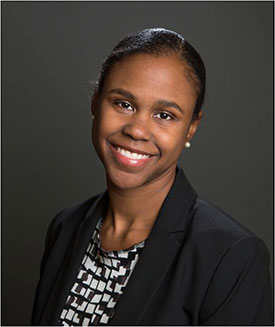
Epidemiologist Tamara James-Todd spoke with Living on Earth about her research on the harmful effects of hair products on Black women’s health. (Photo: Harvard T.H. Chan School of Public Health)
CURWOOD: Wait. So, what's in the stuff that's going on one's body is not on the label?
JAMES-TODD: Correct, and so, of concern, of course, is that then we're completely relying on the companies to test for the safety of our products. And it doesn't take a lot of thought, but that seems like a conflict of interest. The company is trying to make a profit. You know, right now, there is some legislation under way and being developed; the Personal Care Product and Safety Act is being developed by Senators Feinstein and Collins to really, kind of, rethink the protocol and the process by which chemicals and ingredients are tested before they make it to our shelves. Because the average consumer thinks that if it's on the shelf, it's safe.
CURWOOD: In the meantime, what's someone to do who says, OMG, this stuff could give me cancer or make me overweight, all kinds of not fun things. How can someone find safe hair care products?
JAMES-TODD: There is a growing amount of information out there around fragrance and considering going fragrance-free. So, that might be a strategy that one takes, maybe reducing the amount of synthetic chemicals that are being used. There's a kind of movement towards “do it yourself,” and then also, I think, you know, it's cultural change. So, we started with this idea of standard of beauty, and it’s, in my opinion, beautiful to see people starting to embrace more natural hair styles which require less chemical exposure. Certainly people are still using some of these other products daily, but the fewer chemicals that one might be using may be helpful.
CURWOOD: How affordable are paraben-free, phthalate-free alternatives to mainstream hair products for black women?
JAMES-TODD: So, I think the bigger question around that is, are they even on the market? There's very limited selection of those products on the market, and where they do exist they are often not necessarily in kind of traditional stores, and are often more expensive. So, in that case, I think that there needs to be more products introduced on the market, with recognition that these products are important to African-American women and that they do have purchasing power. This is a very large industry.
CURWOOD: We've been talking about women here, but of course, men use these hair care products. What risks do black men, do men of color, run when it comes to hair care products?
JAMES-TODD: It's funny you should ask that. One of the issues that came up when we were doing the Greater New York Hair Products Study that we did back in the early 2000s was that we were just collecting data on women. And one of our largest catchment areas when we were doing recruitment was at churches, and so we would go in and make our little pitch and I'll never forget, one gentleman and his son stood up and said, "What about us? We use hair products as well!" And I said, “Well, we're not really studying you right now." We were interested in breast cancer at the time which was part of the reason why we weren't studying men -- not that men can't have breast cancer! -- but it was one of those things where it was kind of an “ah-ha” moment and so the reality is that black men are using these products too. Oftentimes they wear shorter hair styles and so if you think about it, the application of some of these products is that much more close to the scalp and absorbed through the scalp, and, you know, could have some similar health implications for diseases that are linked to some of these endocrine-disrupting chemicals.
CURWOOD: Talk to me about your own hairstyle, Dr. James-Todd, and what you use and what advice based on your own experience -- just anecdotally -- what advice you would make based on that experience.
JAMES-TODD: So, I remember when I was probably about eight or nine years old, and my mom took me to that, you know, beauty salon and I very much remember one of my first visits there. And again this is at a time period and an era where straight hair was what was acceptable, and so I had a perm done. And all my hair fell out. [LAUGHS] And I was done. I didn't want to do that anymore, and so I have been natural since the late 80s. And I remember that that was at a time where my grandmother, who was born in Tennessee, did not think that was acceptable at all. And I like my curly hair, and so it's been interesting to watch this transition happen before my eyes. I went to school in the south, too, I went to Vanderbilt University, and I remember many of the other black women thinking, like, why would she wear her hair like that, or thinking I was from a different country, because if I was American, I would not wear my hair this way. And it's been beautiful to see people embracing their hair. I am fragrance-free. I've been using the same product now for the past 30-plus years. Thank goodness it's still on the market! [LAUGHS] But, you know, I have a daughter as well and I use that same product on her. I think that minimizing -- again, my philosophy is if I can minimize the amount of products and maintain natural hair that's healthy, then that's good enough for me. As far as advocating for other women, I understand that some people don't feel as comfortable, you know, doing that, or they think that it'll affect their job or other issues. But I think as society changes its standards of beauty, it's been nice to see that being embraced.
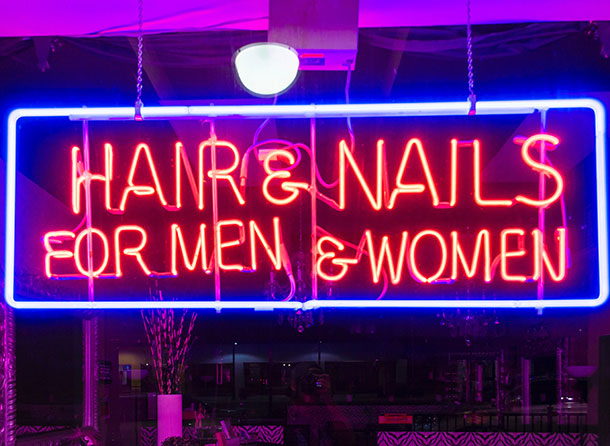
For many in the black community, hair care is a process that may involve different products like leave-in conditioners, root stimulators and anti-frizz polishers – but it’s also an important community activity. (Photo: Andrew Ruiz, Unsplash)
CURWOOD: Now people can go on our website to see your beautiful hair, but if they can't, it's lustrous, shiny, pulled back in a bun in the back. You must use a fair amount of oil.
JAMES-TODD: So, I do use this, it’s really a leave-in conditioner, and water. [LAUGHS] So, that's about it for me. But I do recognize that that's not what everyone else could do.
CURWOOD: [LAUGHS] Dr. Tamarra James-Todd is an epidemiologist with the Harvard T.H. Chan School of Public Health. Thanks so much for taking the time with us today.
JAMES-TODD: Thank you.
CURWOOD: That segment was originally broadcast in 2018. The Personal Care Products Safety Act originally proposed by Senators Diane Feinstein and Susan Collins in 2015 was finally enacted by the Congress in the 2022 Omnibus Bill.
Related links:
- The Greater New York Hair Care Products Study
- About the Silent Spring Institute study
- More on Tamarra James-Todd
- More about Change-maker Madame C.J. Walker
[MUSIC: Poncho Sanchez, “Afro-Cuban Fantasy” on Afro-Cuban Fantasy, Concord Records, Inc.]
CURWOOD: Next week on Living on Earth we wrap up Black History Month with a look at using genealogy to uncover burial sites of enslaved people in Louisiana’s Cancer Alley.
GOBERT: For me I think everybody should revere them, they should be proud of them, they should say their names. And the only way we can get to say their names is looking at these documents to find out who they are.
CURWOOD: Residents along the Mississippi are looking to their ancestors to help them fight the modern petrochemical industry. Tune in next week to Living on Earth from PRX.
[MUSIC: Poncho Sanchez, “Afro-Cuban Fantasy” on Afro-Cuban Fantasy, Concord Records, Inc.]
CURWOOD: Living on Earth is produced by the World Media Foundation.
Our crew includes Fern Al-ling, Naomi Arenberg, Bobby Bascomb, Paloma Beltran, Iris Chen, Josh Croom, Jenni Doering, Mark Kausch, Mark Seth Lender, Don Lyman, Jusneel Mahal, Louis Mallison, Aynsley O’Neill, Sophia Pandelidis, Jake Rego, El Wilson, and Jolanda Omari. Tom Tiger engineered our show. Alison Lirish Dean composed our themes. You can hear us anytime at L-O-E dot org, Apple Podcasts and Google Podcasts, and like us, please, on our Facebook page - Living on Earth. We tweet from @livingonearth. And find us on Instagram at livingonearthradio. And you can write us at comments@loe.org. I’m Steve Curwood. Thanks for listening!
ANNOUNCER: Funding for Living on Earth comes from you, our listeners, and from the University of Massachusetts, Boston, in association with its School for the Environment, developing the next generation of environmental leaders. And from the Grantham Foundation for the protection of the environment, supporting strategic communications and collaboration in solving the world’s most pressing environmental problems.
ANNOUNCER 2: PRX.
Living on Earth wants to hear from you!
Living on Earth
62 Calef Highway, Suite 212
Lee, NH 03861
Telephone: 617-287-4121
E-mail: comments@loe.org
Newsletter [Click here]
Donate to Living on Earth!
Living on Earth is an independent media program and relies entirely on contributions from listeners and institutions supporting public service. Please donate now to preserve an independent environmental voice.
NewsletterLiving on Earth offers a weekly delivery of the show's rundown to your mailbox. Sign up for our newsletter today!
 Sailors For The Sea: Be the change you want to sea.
Sailors For The Sea: Be the change you want to sea.
 The Grantham Foundation for the Protection of the Environment: Committed to protecting and improving the health of the global environment.
The Grantham Foundation for the Protection of the Environment: Committed to protecting and improving the health of the global environment.
 Contribute to Living on Earth and receive, as our gift to you, an archival print of one of Mark Seth Lender's extraordinary wildlife photographs. Follow the link to see Mark's current collection of photographs.
Contribute to Living on Earth and receive, as our gift to you, an archival print of one of Mark Seth Lender's extraordinary wildlife photographs. Follow the link to see Mark's current collection of photographs.
 Buy a signed copy of Mark Seth Lender's book Smeagull the Seagull & support Living on Earth
Buy a signed copy of Mark Seth Lender's book Smeagull the Seagull & support Living on Earth

